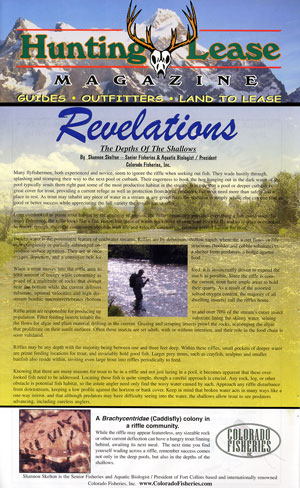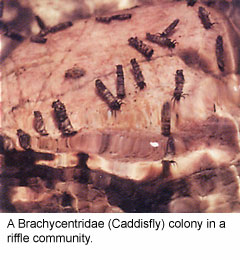
The Depths of The Shallows
By Shannon Skelton - Senior Fisheries and Aquatic Biologist / President
CFI
Many flyfisherman, both experienced and neophyte, seem to ignore the riffle when seeking out fish. They wade hastily through, splashing and stomping their way to the next pool or cutbank. Their eagerness to hook the hog hanging out in the dark water of the pool typically sends them right past some of the most productive habitat in the stream. It is true that a pool or deeper cutbank is great cover for trout, providing a current refuge as well as a refuge from aerial predators, but trout need more than safety and a place to rest. As trout may inhabit any piece of water in a stream at any given time, the question is simply where else can one find as good or better success while appreciating the full variety the stream has to offer.
Long overlooked as prime trout habitat by the majority of fisherman, the riffle community holds everything a fish could want. To many fishermen, the riffle looks like a flat, featureless piece of water, beckoning to snag your favorite fly and so is often overlooked. In reality, though, the riffle community abounds with life and velocity sanctuaries, creating perfect habitat for trout.
Long overlooked as prime trout habitat by the majority of fisherman, the riffle community holds everything a fish could want. To many fishermen, the riffle looks like a flat, featureless piece of water, beckoning to snag your favorite fly and so is often overlooked. In reality, though, the riffle community abounds with life and velocity sanctuaries, creating perfect habitat for trout.
Broken water is the preeminent feature of coldwater streams. Riffles are by definition, shallow rapids where the water flows swiftly over completely or partially submerged obstructions (boulder and cobble substrate) to produce surface agitation. They are at once a shelter from predators, a hedge against oxygen depletion, and a conveyor belt of food.
 When a trout moves into the riffle area to feed, it is instinctually driven to expend the least amount of energy while consuming as much as possible. Since the riffle is composed of a multitude of rocks that disrupt the current, trout have ample areas to hold near the bottom while the current delivers their quarry. As a result of the assorted substrate, optimal velocities and high dissolved oxygen content, the majority of all stream benthic macroinvertebrates (bottom dwelling insects) call the riffles home.
When a trout moves into the riffle area to feed, it is instinctually driven to expend the least amount of energy while consuming as much as possible. Since the riffle is composed of a multitude of rocks that disrupt the current, trout have ample areas to hold near the bottom while the current delivers their quarry. As a result of the assorted substrate, optimal velocities and high dissolved oxygen content, the majority of all stream benthic macroinvertebrates (bottom dwelling insects) call the riffles home.
Riffle areas are responsible for producing up to and over 70% of the stream's entire insect population. Filter feeding insects inhabit the substrate lining the skinny water, seining the flows for algae and plant material drifting in the current. Grazing and scraping insects prowl the rocks, scavenging the algae that proliferate on their sunlit surfaces. Often these insects are set adrift, with or without intention, and their role in the food chain is soon validated.
Riffles may be any depth with the majority being between one and three feet deep. Within these riffles, small pockets of deeper water in a riffle are prime feeding locations for trout, and invariably hold good fish. Larger prey items such as crayfish, sculpins and smaller baitfish also reside within, inviting even large trout into riffles periodically to feed.
 Knowing that there are many reasons for trout to be in a riffle and not just lazing in a pool, it becomes apparent that these overlooked fish need to be addressed. Locating these fish is quite simple, though a careful approach is crucial. Any rock, log, or other obstacle is potential fish habitat, so the astute angler only needs to find the wavy water caused by such.
Knowing that there are many reasons for trout to be in a riffle and not just lazing in a pool, it becomes apparent that these overlooked fish need to be addressed. Locating these fish is quite simple, though a careful approach is crucial. Any rock, log, or other obstacle is potential fish habitat, so the astute angler only needs to find the wavy water caused by such.
Approach any riffle disturbance from downstream, keeping a low profile against the horizon or bank cover. Keep in mind that broken water acts in many ways like a one-way mirror, and that although predators may have difficulty seeing into the water, the shallows allow trout to see predators advancing, including careless anglers.
While the riffle may appear featureless, any sizeable rock or other current deflection can have a hungry trout finning behind, awaiting its next meal. The next time you find yourself wading across a riffle, remember that success comes not only in the deep pools, but also in the depths of the shallows.
 When a trout moves into the riffle area to feed, it is instinctually driven to expend the least amount of energy while consuming as much as possible. Since the riffle is composed of a multitude of rocks that disrupt the current, trout have ample areas to hold near the bottom while the current delivers their quarry. As a result of the assorted substrate, optimal velocities and high dissolved oxygen content, the majority of all stream benthic macroinvertebrates (bottom dwelling insects) call the riffles home.
When a trout moves into the riffle area to feed, it is instinctually driven to expend the least amount of energy while consuming as much as possible. Since the riffle is composed of a multitude of rocks that disrupt the current, trout have ample areas to hold near the bottom while the current delivers their quarry. As a result of the assorted substrate, optimal velocities and high dissolved oxygen content, the majority of all stream benthic macroinvertebrates (bottom dwelling insects) call the riffles home. Riffle areas are responsible for producing up to and over 70% of the stream's entire insect population. Filter feeding insects inhabit the substrate lining the skinny water, seining the flows for algae and plant material drifting in the current. Grazing and scraping insects prowl the rocks, scavenging the algae that proliferate on their sunlit surfaces. Often these insects are set adrift, with or without intention, and their role in the food chain is soon validated.
Riffles may be any depth with the majority being between one and three feet deep. Within these riffles, small pockets of deeper water in a riffle are prime feeding locations for trout, and invariably hold good fish. Larger prey items such as crayfish, sculpins and smaller baitfish also reside within, inviting even large trout into riffles periodically to feed.
 Knowing that there are many reasons for trout to be in a riffle and not just lazing in a pool, it becomes apparent that these overlooked fish need to be addressed. Locating these fish is quite simple, though a careful approach is crucial. Any rock, log, or other obstacle is potential fish habitat, so the astute angler only needs to find the wavy water caused by such.
Knowing that there are many reasons for trout to be in a riffle and not just lazing in a pool, it becomes apparent that these overlooked fish need to be addressed. Locating these fish is quite simple, though a careful approach is crucial. Any rock, log, or other obstacle is potential fish habitat, so the astute angler only needs to find the wavy water caused by such. Approach any riffle disturbance from downstream, keeping a low profile against the horizon or bank cover. Keep in mind that broken water acts in many ways like a one-way mirror, and that although predators may have difficulty seeing into the water, the shallows allow trout to see predators advancing, including careless anglers.
While the riffle may appear featureless, any sizeable rock or other current deflection can have a hungry trout finning behind, awaiting its next meal. The next time you find yourself wading across a riffle, remember that success comes not only in the deep pools, but also in the depths of the shallows.
Shannon Skelton is the Senior Fisheries and Aquatic Biologist / President of Fort Collins Based and internationally renowned CFI. www.cfiglobal.com